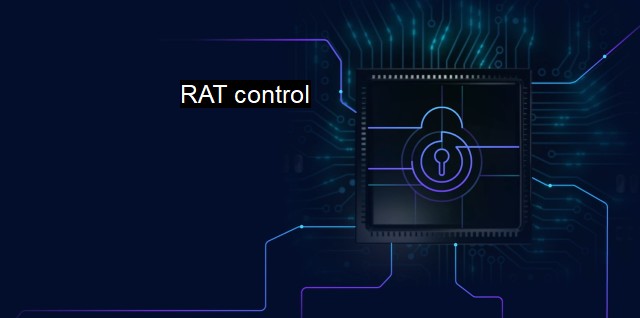What is RAT control?
Strategies for Effective RAT Control in Cybersecurity: Preventing, Detecting, and Mitigating Remote Access Trojans and Other Malware Attacks
RAT control refers to the techniques and measures employed to counter the impact or infiltration of Remote Access Trojans (RATs), within the context of cybersecurity and antivirus. A Remote Access Trojan, often abbreviated as RAT, is a highly detrimental type of malware that once installed on a machine, allows an unauthorized individual to control it remotely. This ill-intended person may then access sensitive information, modify system configurations, use the infected system for building botnets, monitor user activity, or even crash the machine in certain cases.Comparatively speaking, compared to other malware or viruses, RATs are more dangerous as they provide repeated unauthorized access to the cyber criminals that may last until they have been detected and removed. That prolonged latent period often results in severe damage when sensitive information is stolen from these systems, especially from corporate databases that might be a goldmine for such malevolent efforts.
The objective of RAT control is as simple as it is complex - to stop remote access exploitation of any systems connected to cyberspace. Mechanically, this involves a meticulous interplay use of various antivirus software, ensuring that the systems are kept updated with the latest protection patch mechanisms, and implementing robust intrusion detection systems.
Cybersecurity emphasizes the use of advanced antivirus software, which can detect and remove these RATs before they can establish a secure footing in the system. The antivirus software regularly scans all incoming files and segments of network traffic for signs of known malware like RATs. Upon finding any signatures that match with a potential RAT, it promptly boots it out, maintaining the integrity of the system.
The antivirus software must be kept updated because new forms of cyber threats emanate daily. If the updates are not regular, some new strand of RAT, unknown to the current antivirus protection, might earmark your system as its breeding ground. Hence, system administrators should ensure that not only is their antivirus software highly potent but also updated against counter-productive factors that emerge as a part of the evolving cyber landscape.
Despite best efforts, it's challenging because the modus operandi of many RAT developers includes staying ahead of the cybersecurity curve by regularly tweaking their malicious codes and methods. Continuous upgrades in antivirus software patches, thus, become profoundly instrumental in the fight against RAT.
In addition to the comprehensive scanning provided with antivirus, enterprises usually implement more advanced Intrusion Detection System programs. An intrusion detection system helps by monitoring and analyzing network activities and identifying national breaches. So if a company or an institution was infiltrated by a RAT, chances are these smart intrusion detection technologies could promptly detect the recursives and irregularities in the patterns that are usual giveaways of any rat infestation.
Behavioral-based intrusion detection is another type of IDS that focuses on recognizing malicious activity on a system or network by profiling the normal activity and tagging any deviations from the standard for automatic alerts or manual follow-ups.
Institutions may also do well to strengthen their password policies and use multi-factor authentication processes. These steps can fortify a system's protection against RATs by making the initial infiltration far more difficult for cyber criminals.
Organizations must educate employees about RATs and other potential cybersecurity threats. Employees could unwittingly open unfamiliar emails and their unknown attachments – common vehicles of RAT intrusion – despite robust safeguards in place.
To summarize, RAT control, while crucial, represents a formidable challenge in the ever-evolving cybersecurity landscape. It requires a comprehensive effort, state-of-the-art antivirus software, and advanced intrusion detection systems. Besides, regular updates, mindful best practices, and continuously raising user awareness define the formidable defense mechanisms necessary to counter these RATs.

RAT control FAQs
What is rat control in cybersecurity?
Rat control in cybersecurity refers to the process of detecting and removing Remote Access Trojans (RATs) from computer systems. RATs are malicious software that allow unauthorized access to a computer or network by remote hackers. Controlling RATs is important in maintaining cybersecurity and preventing potential data breaches.How can I detect a RAT in my system?
There are several signs that indicate the presence of a RAT in your system, such as unusual network traffic, spikes in CPU or memory usage, unfamiliar processes running in the background, and changes in system settings or files. You can use antivirus software and malware scanners to detect and remove RATs from your system.What are the risks of not controlling RATs in my system?
Not controlling RATs can lead to serious consequences, such as theft of personal information, financial fraud, unauthorized access to sensitive data, and even complete loss of control of the affected device. RATs can also be used as a backdoor to install other malware on your system.How can I prevent RATs from infecting my system?
To prevent RATs from infecting your system, you should maintain strong security practices, such as using reputable antivirus software, keeping your software and operating system up-to-date, avoiding suspicious links and attachments, and regularly backing up your data. You should also educate yourself and your employees on safe online practices and remain vigilant against potential threats.| | A | | | B | | | C | | | D | | | E | | | F | | | G | | | H | | | I | | | J | | | K | | | L | | | M | |
| | N | | | O | | | P | | | Q | | | R | | | S | | | T | | | U | | | V | | | W | | | X | | | Y | | | Z | |
| | 1 | | | 2 | | | 3 | | | 4 | | | 7 | | | 8 | | |||||||